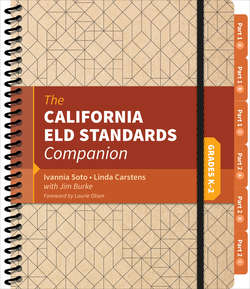Читать книгу The California ELD Standards Companion, Grades K-2 - Jim Burke - Страница 37
На сайте Литреса книга снята с продажи.
Grades K–2 Interacting in Meaningful Ways Collaborative Standard 2
ОглавлениеWhat the Teacher Does
A great deal of writing in kindergarten occurs when children—as an entire class, in small groups, or as individuals—dictate their ideas to an adult who records them. Children also express themselves in writing independently, beginning with marks and scribbles that soon become strings of letters. Eventually, as they learn about the sound structure of language (that is, they become phonemically aware) and about the symbols that represent sounds (that is, the letters of the alphabet), children begin to use that knowledge in their writing. Words are phonetically spelled at this stage of learning. This is an important milestone representing children’s growing understanding of the alphabetic principle—crucial for independence in both writing and reading (2014 ELA/ELD Framework, p. 207).
Teachers and students can jointly compose projects of short informational and literary texts that include minimal writing (labeling with a few words):
Teachers can chart student responses to picture prompts or instructional read alouds, in order to model the writing process.
The teacher can model how to use a word bank to complete cloze passages that models effective writing.
Children progress considerably in their writing, both in terms of substance (including organization and style) and mechanics during Grade 1. They have daily opportunities to write with their teacher, their peers, and on their own for a variety of purposes and in a variety of contexts. They write in learning and literature response journals. They write messages to others. They write directions for visitors. They write lists of ways to improve the playground. Children learn to reflect on the effectiveness of their own and others’ writing as they share their written work. Some selections are revised after feedback from the teacher or peers (W.1.5). Some are published, such as when each child contributes a page produced digitally to a class book. Children engage deeply with a number of texts, use language to communicate with peers, and problem solve as they pursue research topics and present in writing what they learned (W.1.7) (2014 ELA/ELD Framework, p. 242).
Teachers and students can jointly write projects of short informational and literary texts, using technology where appropriate for publishing, graphics, and the like:
The teacher can continue to chart student responses to writing, as well as use sentence frames with word banks to complete their writing assignments.
Teachers can provide contextualized ensure classroom experiences, such as exploring their playground or school garden, to build background knowledge and ensure that students have enough information to write about.
Teachers can use a document camera to think aloud regarding writing prompts and model writing in a notebook or digital book.
Teachers continue to read a variety of texts with students, in order to build background knowledge on topics being written about.
The teacher can use graphic organizers with cloze passages that include language features such as transition words. For example, “In the beginning of the story, ______. Secondly, ______. Lastly, ______.” The teacher can model for students how to complete their first response using details from a text. In pairs, students can complete the second sentence, and then each student can complete the last part.
Using keyboarding skills in Grade 3 to produce and publish writing (W.2–3.6).
The teacher can directly teach keyboarding skills and provide ample time for practice of such skills to produce writing.
